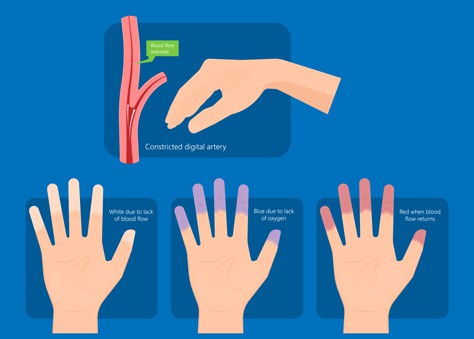Cold hands and feet
Help, you are freezing c-c-cold, even in summer!
The sparrows are falling from the roof and you are walking around with cold hands. Not as cold as in winter, but still. Especially if you sit still for a long time and especially if you have touched a cold object. You prefer to turn on the hot tap to warm up your fingers. Sound familiar? Then it could be that you have Raynaud’s syndrome.
This is a disease in which your body finds it difficult to keep the blood circulation going all the way to the smaller vessels. The extremities of your body contain the smallest vessels, so your toes, fingers, tip of your nose and ears are the first places to experience the cold.
Do you have Raynaud’s syndrome?
How do you know for sure if you have Raynaud’s syndrome? If you answer the following questions with ‘yes’, this syndrome may be the cause of your cold hands and often feet as well.
Cold because of emotions
When you have an important conversation or are nervous about something, do your hands get cold more often?
Cold by a cold object
If you have grasped a cold object, do your hands stay cold for long?
Skin colour
Do you recognise that your fingers and often toes do not have a normal well-circulated skin colour but instead turn white and often bluish?
Oh dear, you answered ‘yes’ three times, should you be worried? No, Raynaud’s syndrome is common in otherwise healthy people. It is just an annoying symptom, about which there is often not much you can do, except the usual tips for cold hands and feet. Such as exercising sufficiently, not smoking, not sitting with your legs crossed, not wearing tight socks and shoes, taking a changing bath to help the circulation. And above all, just keep your hands and feet nice and warm by taking a bath or treating yourself to a pair of heated gloves and heated socks.
If you have answered “no” to any of the above but still suffer from cold hands and/or feet in the summer, here are some other causes (and great tips!) of cold hands and feet.
When do I need to worry?
If your fingers or toes go from white and purple to red and or purple, you have a severe variant of the symptom. Even then, there is nothing wrong, but it would be better for your own peace of mind to pay a visit to your doctor. Often, your fingers or toes also feel numb and then it is no fun at all to go about your daily work and other activities.

It may also be the case that Raynaud’s disease is a symptom of an underlying problem. For example, it is more common in people who suffer from cardiovascular diseases or from a form of rheumatism. So a visit to the doctor will certainly not hurt.
What can a doctor do?
First of all, a doctor can assess whether you actually have Raynaud’s disease. He or she does this by cooling your hand and making an X-ray. It shows the four arteries of the hand and the smallest capillaries in the nail bed of the finger.
To be on the safe side, the doctor will also order a urine test to check the further health of your body.
Then the doctor can assess whether vasodilator drugs or ointments are useful. An operation is only necessary in very exceptional cases. During surgery, the nerve responsible for constricting the blood vessels is switched off. To be sure whether such an operation makes sense, the doctor numbs the nerves locally. If this has a positive effect – i.e. if the blood vessels no longer constrict – it can be assumed that an operation will be useful.
By the way, did you know that women suffer from this syndrome 8 times more often than men? You can tell your husband this when you want to warm up those ice cubes on his warm legs in bed. Even in high summer. There is nothing strange about that, it just belongs to you!

